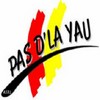1) ADULTS GROUP
It has been trained by two choreographers: Marc MALEMPRE, for historical dances and Walloon dances, and the late Renaat VAN CRAENENBROECK.
The original choreographies, created with the help of a local historian, are punctuated with songs.
Historical dances Renaissance dance suites have been created with minute attention to detail regarding the costumes and the authenticity of the dance steps.
Two shows have been produced with greatly differing atmospheres:
– Ball at the court of ‘La Péronnelle’
-Breughelian dances ‘Has-tu point vu ?’
Walloon dances These 19th century dances form suites of a variety of styles:
– ‘Le Mariage’: reconstructing the atmosphere of a bygone era, from the formal family group photograph to celebration.
– ‘Le Bal de l’Etrange’: ritual dances revolving around the symbols of spring and revival (dance of the seven leaps, pole dance, etc.).
– ‘Le Ballotil’ or ‘Riche plus tard’: local working-class scenes.
– ‘L’Attente’: about conscripts leaving to join the army, carnival and dance scenes, etc.
Flemish dances Based on the polka, the waltz, Scottish-dancing and the mazurka, these suites of dances are astonishing
for their sheer virtuosity and lightness and demand an exceptionally high level of technique and cohesion on the part of the dancers.
In the last five years, the group has performed :
– abroad: at the ‘Européades’ in Valencia, Spain, the Szeged International Festival in Hungary, the Schlitz International Festival in Germany and the Riga International Festival in Latvia;
– in Belgium: at the Marcinelle International Festival, the Tournai International Folklore Festival, the Saint-Ghislain World Folklore Festival,
the Schoten (Antwerp) International Folklore Festival, as part of ‘Les Triomphes de Binche’, on the occasion of the 15th anniversary of the ‘Infants du Catiau’ group in Tournai,
the 15th anniversary celebrations of the ‘Roctiers’ group in Tournai, the Folklore Festival in Tournai, the DAPO National Contests, the Western Hainaut Contests in Quevaucamps,
the Lessines Feast Festivities (several times), the Midsummer’s Day celebrations in Enghien, in Malmédy, Ath and Ellignies-Sainte-Anne, in Hollain as part of ‘l’Artifoire’,
the Medieval Celebrations in Moha (Huy), a performance organised as part of the ‘Télévie’ in Quevaucamps, at Anvaing castle’s,
Midsummer’s Day celebrations in Visé, on the occasion of the ‘Schubertiades’ at Beloeil castle, at the medieval celebrations in Braine-le-Château,
at the Heritage Festival in Quevaucamps, on the first ‘Nuit des Lum’rottes’ in Quevaucamps, etc.
2) JUNIORS GROUP
Set up in 1995, this group presently comprises some twenty dancers split up into two age groups.
The older members are included in the Adult Group and join up with the Junior Group to perform Flemish or Czech suites.
They are trained by three choreographers: Marc MALEMPRE for Walloon and historical dances which they practice together with the Adult Group, Eva and Radek REJCZEK for Czech dances,
and up to July 2001, by the late Renaat VAN CRAENENBROECK (U ) for Flemish dances.
In order to deliver a top quality performance, they receive rigorous training in singing and dance techniques.
In the past five years the group has given public performances :
– abroad: in various places on a tour of the Czech Republic, at the Riga International Festival (Latvia);
– ein Belgium: at the Saint-Ghislain World Folklore Festival, the Schoten (Antwerp) International Folklore Festival, the International Children’s Contest in Vaulx (Tournai),
the Tournai Folk Festival, the Medieval Celebrations in Moha (Huy), the Lessines Feast Festivities, the DAPO National Contests,
the Heritage Festival in Quevaucamps, on the first ‘Nuit des Lum’rottes’ in Quevaucamps, in Ath, together with a performance organised as part of the ‘Télévie’ in Quevaucamps,
and various performances in aid of the O.N.E. (National Children’s Organisation), children in Tchernobyl, deprived children of the C.P.A.S. in Ath, UNICEF, the League of Families, etc.
3) SWORD DANCES
Set up in 1995, the team of Sword dancers performs a ritual and original dance two weeks before Easter.
It is a staging of the execution of Galouche, the mythical wolf, killed at Quevaucamps at the end of the 17th century.
It is made up of some ten dancers (exclusively male), a few musicians, and, larger than life… a wolf!
Won over to this type of dance, the team has added a Czech sword dance to its repertoire and is currently preparing an English sword dance.
A number of renowned choreographers, including the late Renaat VAN CRAENENBROECK (U ),
Eva and Radek REJCZEK and Trevor STONE, have already enthusiastically turned their skills to coaching this promising new team.
The sword dancers have already given public performances:
– in Belgium: in the various communities of the Beloeil district on the occasion of their yearly outing and also in Antwerp, Lessines, Braîne-le-Château, Anvaing castle, Saint-Ghislain, Binche and Quevaucamps;
– at the Scarborough (England) National Festival, the Kirtlington (England) Festival, in Dunkirk (France) and Coventry (England), at the Riga International Festival (Latvia).

